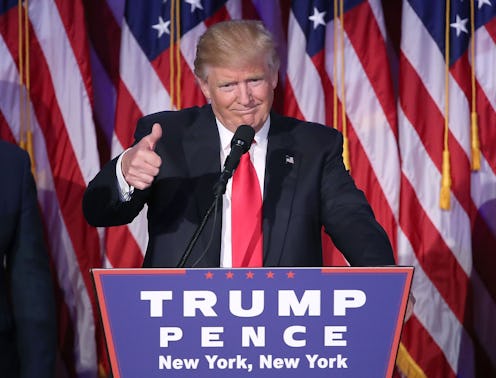Amongst all the fear and anguish and despondency that has been dominating headlines in post-election United States, much about the electoral college has been floating through our country's discourse as well. The topic has come up frequently in conversations wondering whether, based on what faithless electors in history have shown, there's a chance that Trump will ultimately lose his position as president-elect of the United States. And before we go any further into this article, I just want to make clear: That is very, very, very unlikely. Granted, we are currently in uncharted waters in America — anything, it seems, is possible at this point. But tying your hopes to the electoral college, rather than preparing for the situation in which we currently find ourselves, probably isn't the way to go. Instead, it's worth looking to what actions you can take now and in the future to protect your rights, be an ally to those who need it, and rally for the causes you hold dear.
But, to the point: What do history's faithless electors tell us?
The electoral college was established by our founding fathers in Article Two of The United States Constitution, as a way to appoint our President and Vice-President. Each state has an established number of electoral votes — currently, there are a total of 538 electors. The first candidate who reaches a majority of electoral votes (270) on Election Day is deemed the President-Elect. On Dec. 19, the electors meet and cast their votes. It is they, ultimately, who determine the President and Vice President. Most of the time, the electors will vote for whichever candidate their state has "pledged" votes towards. But once in a while, a "faithless elector" appears — that is, someone who breaks their state's pledge and casts their vote for a different candidate.
In 2016, for the second time in 16 years — the first being the 2000 election — a Democratic candidate lost the electoral college race, but ultimately won the popular vote (as in, how many individuals in the country actually voted). Notably, before the 2000 election, the last this outcome had been recorded was all the way back in 1888. If Trump does not receive a majority of elector votes on Dec. 19, 2016, then the fate of the presidency will be in the hands of the House of Representatives. Don't get too excited — there are currently 247 Republicans and 188 Democrats in the House, so odds are the outcome in this already unlikely situation won't be quite what you might be hoping for.
Breathe deep, stay strong, be kind, and read up on past cases of faithless electors. They can give us a window into what to expect about the 2016 election.
1836
In 1836, the state of Virginia's entire electoral delegation — 23 men — faithlessly voted against victorious Democratic Party Vice Presidential Candidate Richard M. Johnson. The reason? Johnson's long-term, public relationship with his slave, Julia Chinn. This decision, which was arguably the most disruptive faithless elector movement in history, meant the presidency was left to the Senate. Ultimately Johnson was elected, along with the Democratic Party's Presidential Candidate, Martin Van Buren.
1872
In 1872, the Democratic Party and the Liberal Republicans nominated Horace Greeley for President of the United States. In between the election and the meeting of the electoral college, Greeley, uh, died. 63 of the 66 Democratic electors refused to vote for a deceased dude; 17 abstained from voting altogether, while the remaining 43 split their votes amongst the other Democratic candidates. Ulysses S. Grant was ultimately elected to a second term in office.
1896
Weirdly, in 1896, both the Democratic Party and the People's Party ran William Jennings Bryan as their Presidential candidate, but nominated different Vice Presidents, which sounds like a mess. The People's Party ultimately won 31 electoral votes, but four of those electors voted for the Democratic ticket instead. William McKinley won the White House.
1948
In 1948, Preston Parks, a Democratic elector from Tennessee, voted for Strom Thurmond, the candidate from the States Rights party, which had formed directly before the election following a division among the Democratic Party. Oy. Harry S. Truman ended up serving his second term as a result of this election.
1968
Dr. Lloyd W. Bailey, a Republican elector from North Carolina, cast his vote for George Wallace, the Independent Party candidate, over Nixon in the 1968 election. Dr. Bailey claimed that he'd been frustrated with a number of Nixon's actions, like his appointing of Henry Kissinger and Daniel Moynihan; he later admitted, however, that if his vote would have truly altered the outcome of the election, it would have been for Nixon.
1972
In 1972, the faithless elector situation was particularly notable, as it was the first time a faithless elector voted for a Libertarian candidate. Roger McBride, a Virginia elector, cast his vote for the newly established Libertarian Party ticket, which included Vice President candidate Tonie Nathan, the first time an electoral vote was cast for a Jewish woman. McBride then went on to become the 1976 Libertarian Party Presidential Candidate, but Richard Nixon landed in the White House for a second term. (He resigned in 1974 after the Watergate scandal.)
2004
The most recent incident of a faithless elector was an anonymous one. In 2004, a Democrat from Minnesota voted for John Edwards, John Kerry's vice presidential running mate at the time, instead of Kerry. Though some have believe this was actually just a mistake, it did lead to Minnesota abolishing its anonymous elector voting tradition.
Images: Giphy (4); Wikimedia Commons (3); Rembrandt Peale/Wikipedia
